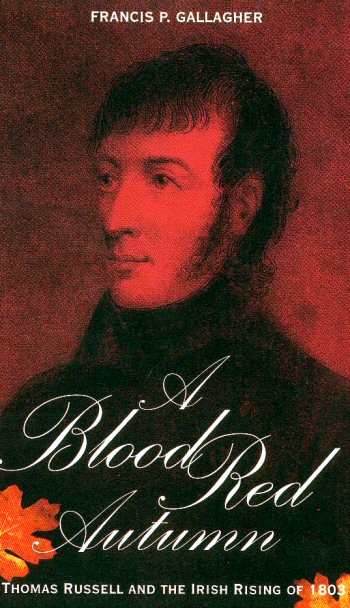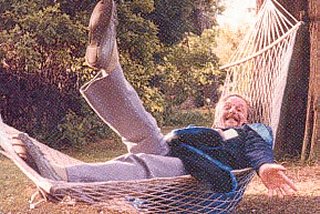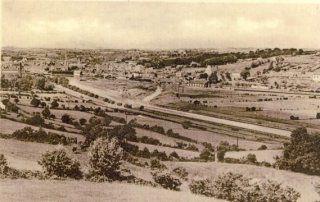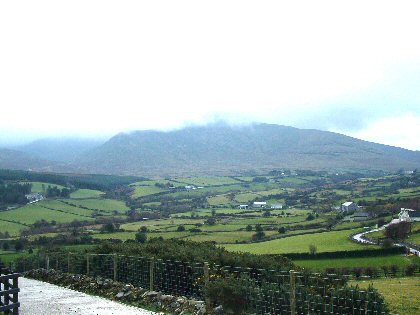‘A Blood Red Autumn: Thomas Russell and the Irish Rising of 1803’ by Francis P Gallagher is designed to shed more light on a subject which till now has received little historical research. The book is available locally at Easons and Waterstones.
Book Reviews
Voices & Sound of Drums
We finally met Peter Shea, son of the author of this book. With his wife Lynn, Peter – who hails from Adelaide, Australia now, though born in Belfast – is on a 10 day tour of Europe (Yes! Europe, no less) and called with your editor in an attempt to find his father’s grave in St Mary’s – and to get a quick look-round Newry.
Roll The Credits
‘Roll the Credits’ is a limited edition biopic of the life’s work and achievements of Newry’s Man of the Century, Sean Hollywood, and is our first book review. Hurry! There may yet be a few copies in Easons, Savages or the Sean Hollywood Arts Centre. This will be a Collector’s Item.
Gap of the North
Cosgrave: Yew Tree at head of Strand
‘The Yew Tree at the Head of the Strand’ was published in 2001 by Liverpool University Press and, a paperback of about 200 pages, retails [or it did when I purchased my copy] at the hefty price of around
It is a memoir of early life in Newry of the 40s and 50s by Brian Cosgrove, brother of Art Cosgrove, 1997 President of UCD and one of the four people principally featured on Haughey’s Folly [Millennium Monument] close to the Five Ways Roundabout.
Brian is Professor of English at Maynooth – and has to incessantly illustrate that fact with innumerable and tiresome references to literary greats throughout his reminiscences.
I find Cosgrove’s style of writing most annoying. I want to read his stories of the O’Hare yacht disaster in Warrenpoint, for example, (dismissed in three short sentences, including an unwarranted speculation as to the cause of the fatalities!) but consider it irksome in the extreme to find it prefaced with a Latin quote, Et in Arcadia Ego which Cosgrave conjures for presumed relevance to his own view of a world overshadowed by death. This tragic tale, infamous at the time remains largely untold (Who were they? How many perished etc?) but for a young Brian “far, far worse was the death of a neighbouring toddler in a road traffic accident! ” (Why was that worse? How many remember that, compared with the O’Hare disaster?)
I feel, though a literary person myself, that this man’s lectures would bore me stiff! He spoils every good story by wrapping it in such pomposity and pretentiousness.
Even his stories about serving in his father’s pub [then just Cosgrove’s, later the Wander Inn – which we suffixed with and Stumble Out – now Soho Place, the best meal in town!] smack of a smart-alec student whom none could like. I find him a boring guy who led a boring childhood, watching others have a good time while, cold-eyed, passing critical judgement on their life styles.
Others I know [our Bishop, for example] enjoyed his book.
Make your own judgement. Find out for yourself.
But I’d respectfully suggest you browse it in the library before purchase.
I don’t feel I got my money’s worth!
Frontier Town: Canavan
The research and writing of ‘Frontier Town : An illustrated History of Newry’ was undertaken by Tony Canavan when he was curator of Newry Museum over a decade ago. Though Canavan is a famous name in Newry, Tony is from Belfast. He returns here shortly to give a lecture in the Carlingford Lough series. I’ll be there.
I am an ardent fan of this wonderful history. It is excellently researched and reads like a racy narrative. We are very lucky to have such a tome at our disposal – that is, those of us who purchased early and have looked after our copy. I say this because Blackstaff [ISBN 0-85640-430-6] unfortunately bound this paperback volume with a brittle gum than deteriorates with time, and most copies are by now, literally in bits!
I seldom hear reference made to Canavan’s work locally – in Newry History Society, for example – and wonder if begrudgery has again raised its ugly head. Certainly any localised research must begin here. His Preface succinctly expresses the role of the town in Irish history. Personally I still prefer Frontier Town to Newry City, the former conjuring thoughts of our pivotal role so often in the past: the latter a sop – from QE2 – to aspiring ‘spinners’.
Those of us who lived through much of the twentieth century may take exception to parts of his final chapters, though it is always most difficult to assess living history. He wrongly identifies Irish Labour [I was a member and attended Annual Conferences in Liberty Hall, Dublin] on Newry Council with Northern Ireland Labour Party and casts the principled rump led by Tommy McGrath as ‘dissidents’ when they were faithful to party policies, whereas Pat McMahon – whom he extols – went on to unfairly allocate homes on the basis of ‘I want my bite of the cherry!’
He dates the Great Hunger from 1844-1849 and alleges it had no effect on the town. Readers of Workhouse History on these pages will disagree! There are other anomalies but errors are few.
If you only ever read one book about Newry, make sure it is Canavan’s!
Voices & The Sound of Drums
I know nothing at all about the book I’m about to ‘review’ except that it was entitled ‘Voices and the Sound of Drums’ and it was written by Patrick Shea and published in 1981 by Blackstaff.
I came across this short excerpt and was mightily impressed. I’ll really have to make an effort to locate it (Amazon, again!) and buy a copy. I hope you conclude likewise.
During our lunch period I walked along North Street, a tumbledown part of old Newry, to the Butter Market and found myself in the midst of a hiring fair; a fair in which the merchandise was human beings. Those doing business were standing about in small groups, talking quietly; a sturdy man holding out for what he thought he was worth as a ploughman, a rosy-cheeked servant girl listening and nodding as details of the offered engagement were explained to her by a farmer and his wife, a mother handing over her fourteen-year-old son on the understanding that in return for his apprentice labour on a farm he would be kept and given three meals a day and after six months she would be paid perhaps five or six pounds.
Hiring fairs were peculiar to the northern part of Ireland.
Do any of you know this book? Was Patrick Shea a relative of Jack, our Laughing Policeman of Derrybeg Lane? And of Dorothy (Dodo to us rude and uncouth schoolboys, although I remember this dear and unassuming teacher taking us for amateur drama practice in the living room of her own home in Derrybeg Lane on Saturday afternoons, for no reward!). Gone now to her eternal reward, it’s too late to tell her how much I appreciated her.
[Yes I know the latter two were brother and sister, and were O’Shea – but that doesn’t exclude the possibility of some familial relationship with the author!]
P.S. I’ve just received an e-mail from Peter, the son of the author of this book. He lives now in Australia but is visiting us in May. And YES, Jack and Dorothy were brother and sister to Patrick.
I’d love to meet him then. Perhaps he will loan me a copy of the book, so I can do a proper review!)
Mourne Country : E E Evans
STOP PRESS *** STOP PRESS *** STOP PRESS *** STOP PRESS *** STOP PRESS ***Mourne Country by E E Evans has been reprinted for Christmas 2005 market. ***
Despite endless hints, not ONE of my large family saw fit to purchase me a copy for a Christmas present. Would YOU like to make an old man very happy?
“Mourne Country” by E E Evans is possibly the most interesting, erudite, amusing, heart-warming and informative tome I have ever read, on the subject of the Mournes and the South Down region. Although written more than half a century ago, its geographic and geological analyses remain – in a world of swift scientific advance and shifting hypotheses – surprisingly intact.
Evans, one-time professor of geography at Queens University, Belfast, was not native to these shores but acquired honorary Irishman status through dedicating much of his academic career and his huge research and literary talents to Irish studies, including the authorship of books on Irish folklore and customs.
No ivory tower academic, Estyn relaxed in the company of the Mourne people of his day, getting to know the landscape with and through them. In his book he knits them into the land’s magnificent architecture with an apparent ease that belies his huge literary talent.
Choose a page at random (here I chose page 15) and marvel at his relaxed but highly charged descriptive powers:
‘..the fortunate climber, from a noble peak, may chance to see a peregrine falcon keeping watch on the lonely hills..’ :
I could be there with him!
I admit that I keep coming back to this delightful book again and again, and always I acquire another little snippet that I appear to have overlooked before. In fact, it’s much like the Mourne walker himself, who is never disappointed in trekking his earlier pathways. Now honestly, how often can that be said about a holiday destination?
I really should not have reviewed this book for you, because now comes the bad news! It has been out of print for many years! Indeed some long time ago – in my enthusiasm to share its delightful charms – I loaned my copy to a ‘friend’ and, of course, never had it returned.
I regularly call into the Newry Library to browse their single remaining copy, and frequently to photocopy its pages. You might want to do likewise. I promise, you will not be disappointed!
‘..valleys nourished by many high springs .. sluggish streams’:
‘.. to one who reads the map with intelligence and feeling, the contours of the Mournes will sing together sweetly.’



